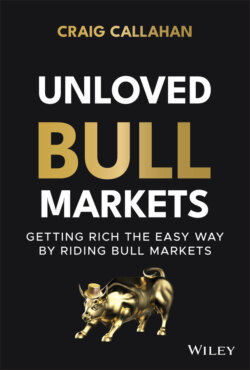Читать книгу Unloved Bull Markets - Craig Callahan - Страница 18
Yields Suggest “Unloved”
ОглавлениеInterest payments on 10-year Treasury notes are fixed over the life of the note. Dividends for companies in the S&P 500 Index have grown through the years. As seen in Figure 1.5 of year-end yields for the 10-year Treasury and the S&P 500 Index, the yield is usually higher for the 10-year Treasury. Investors are willing to accept a lower current yield on stocks because they expect the dividends to grow. Since 1962, the yield on the 10-year Treasury has exceeded the yield on the S&P 500, on average, by about 300 basis points.
Figure 1.5 Yields: S&P 500 and 10-Year Treasury 1962–2020
There have been six times when the yield on the S&P 500 Index has been greater than the yield on the 10-year Treasury: year-ends 1962, 2008, 2011, 2012, 2019, and 2020. Once the two were about equal: year-end 2015. What was going on these seven times to reverse a normal, rational yield relationship? News events at the time of a few of these could explain investor behavior. The Cuban Missile Crisis was October 1962. The financial crisis was October 2008. The European debt crisis round two was September 2011. Investors were obviously afraid of owning stocks and were clinging to the safety of Treasury notes. They sold stocks and bid up the price of the Treasury notes, which lowered their yield. Five times during this multiyear bull market, investors disliked stocks so much, we were offered a higher yield on the S&P 500 than on the 10-year Treasury, despite the potential for the S&P 500 to provide dividend growth and capital appreciation. We had not seen this desperate yield relationship for forty-six years, then it appeared five times just before and during this multiyear bull market.
When the yield on the S&P 500 is equal to or exceeding the yield on the 10-year Treasury it signals that stocks are cheap and bonds are expensive. It is telling us investors like bonds and dislike equities and has been a very good “buy” signal for equities. Table 1.3 shows the rates of return for the S&P 500 for one and two years after the seven times of unusual relative yields.
Table 1.3 Rates of Return for the S&P 500 (%)
| Year | One-Year | Two-Year |
|---|---|---|
| 1962 | 22.8 | 42.9 |
| 2008 | 26.5 | 45.5 |
| 2011 | 16.0 | 53.6 |
| 2012 | 34.6 | 53.0 |
| 2015 | 12.0 | 36.4 |
| 2019 | 18.3 | ??? |
| 2020 | ??? | ??? |
